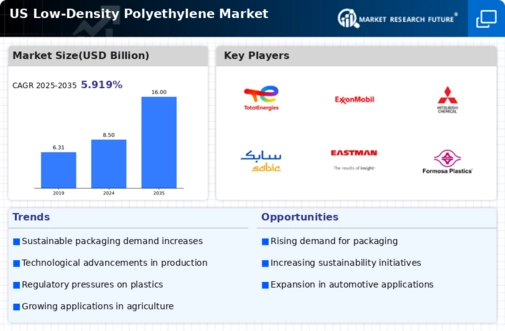The low density polyethylene market exhibits a dynamic competitive landscape characterized by robust growth drivers such as increasing demand from packaging, automotive, and consumer goods sectors. Major players like ExxonMobil (US), Dow (US), and LyondellBasell (US) are strategically positioned to leverage their extensive production capabilities and technological advancements. ExxonMobil (US) focuses on innovation in polymer production, while Dow (US) emphasizes sustainability initiatives, aiming to reduce carbon emissions in its operations. LyondellBasell (US) is actively pursuing regional expansion to enhance its market presence, which collectively shapes a competitive environment that is increasingly focused on sustainability and technological innovation.
Key business tactics within this market include localizing manufacturing and optimizing supply chains to enhance efficiency and responsiveness to market demands. The competitive structure appears moderately fragmented, with several key players exerting influence over market dynamics. This fragmentation allows for a variety of strategies to coexist, fostering innovation and competition among the leading companies.
In November 2025, Dow (US) announced a partnership with a leading technology firm to develop advanced recycling technologies aimed at increasing the circularity of low density polyethylene products. This strategic move is significant as it aligns with global sustainability goals and positions Dow (US) as a leader in eco-friendly practices within the industry. The partnership is expected to enhance Dow's product offerings and appeal to environmentally conscious consumers.
In October 2025, LyondellBasell (US) unveiled plans to invest $500 million in expanding its production capacity for low density polyethylene in the Gulf Coast region. This investment is crucial as it not only increases LyondellBasell's output but also strengthens its supply chain resilience, allowing the company to meet the growing demand in North America. Such capacity expansions are indicative of the company's commitment to maintaining a competitive edge in a rapidly evolving market.
In September 2025, ExxonMobil (US) launched a new line of low density polyethylene products designed specifically for the food packaging sector, which is experiencing heightened demand for sustainable materials. This launch reflects ExxonMobil's strategic focus on innovation and market responsiveness, potentially enhancing its market share in a lucrative segment. The introduction of these products is likely to attract new customers and reinforce existing relationships with key clients in the food industry.
As of December 2025, current competitive trends are increasingly defined by digitalization, sustainability, and the integration of AI technologies into production processes. Strategic alliances are shaping the landscape, enabling companies to pool resources and expertise to tackle complex challenges. Looking ahead, competitive differentiation is expected to evolve from traditional price-based competition to a focus on innovation, technological advancements, and supply chain reliability. This shift underscores the importance of adaptability and forward-thinking strategies in maintaining a competitive advantage in the low density polyethylene market.























Leave a Comment